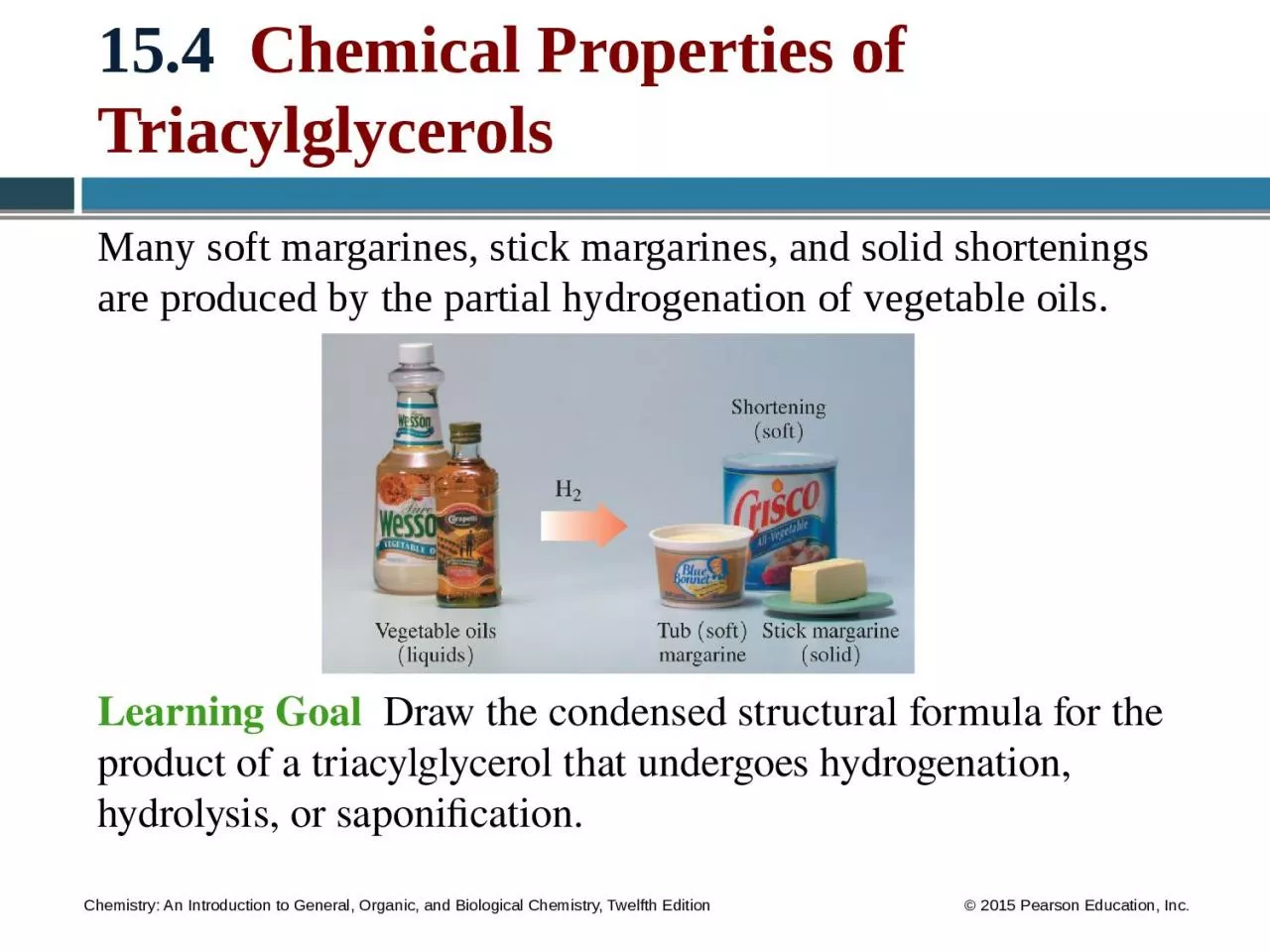

Triacylglycerols Many soft margarines stick margarines and solid shortenings are produced by the partial hydrogenation of vegetable oils Learning Goal Draw the condensed structural formula for the product of a triacylglycerol that undergoes hydrogenation hydrolysis or saponification ID: 915686
Download Presentation The PPT/PDF document "15.4 Chemical Properties of" is the property of its rightful owner. Permission is granted to download and print the materials on this web site for personal, non-commercial use only, and to display it on your personal computer provided you do not modify the materials and that you retain all copyright notices contained in the materials. By downloading content from our website, you accept the terms of this agreement.
Slide1
15.4 Chemical Properties of Triacylglycerols
Many soft margarines, stick margarines, and solid shortenings are produced by the partial hydrogenation of vegetable oils.
Learning Goal Draw the condensed structural formula for the product of a triacylglycerol that undergoes hydrogenation, hydrolysis, or saponification.
Slide2Triacylglycerols: HydrogenationIn hydrogenation reactions, double bonds in unsaturated fatty acids react
with hydrogen gas to produce carbon–carbon single bondshydrogen
gas is bubbled through the heated oil, typically in the presence of a nickel catalyst
Core Chemistry Skill
Identifying the Products for the Hydrogenation, Hydrolysis, and Saponification of a
Triacylglycerol
Slide3Hydrogenation ReactionsWhen hydrogen adds to all of the double bonds of glyceryl trioleate (triolein) using a nickel catalyst, the product is the saturated fat glyceryl tristearate (tristearin).
Slide4Hydrogenation ReactionsIn commercial hydrogenation,the addition of hydrogen is stopped before all the double bonds in a liquid vegetable oil become completely saturated
the partial hydrogenation of a liquid vegetable oil changes it to a soft, semisolid fatthe more saturated product has a higher melting point
Slide5Study CheckWhat products are obtained from the complete hydrogenationof glyceryl trioleate?A. glycerol and three oleic acids
B. glyceryltristearateC. glycerol and three stearic acids
Slide6SolutionWhat products are obtained from the complete hydrogenation of glyceryl trioleate?
B. glyceryltristearate
Slide7Chemistry Link to Health:Trans Fatty AcidsUnsaturated fatty acids can be cis, with bulky groups on the same side of C C
trans, with bulky groups on opposite sides of C C
Slide8Hydrogenation: Trans Fatty AcidsDuring hydrogenation, double bonds are converted to C —
C single bonds a small number of the cis
double bonds are converted to more stable trans double bonds, causing a change in the overall structure of the fatty acidsIn the body, trans fatty acids behave like saturated fatty acidsare estimated to be 2–4% of our total calories raise LDL-cholesterol and lower HDL-cholesterol
Slide9Hydrogenation: Trans Fatty Acids
Slide10Trans Fatty Acids in FoodsFoods containing naturally occurring trans fatty acids include milk, eggs, and beef.Foods that contain trans fatty acids from the hydrogenation process include deep-fried foods
bread, baked goods, and cookiescrackers and chips
stick and soft margarinesvegetable shortening
Slide11Study CheckWhich of the following statements are true and which are false?A. There are more unsaturated fats in vegetable oils.
B. Vegetable oils have higher melting points than fats. C. Hydrogenation of oils converts some cis double bonds
to trans double bonds.D. Animal fats have more saturated fats.
Slide12SolutionWhich of the following statements are true and which are false?A.
True There are more unsaturated fats in vegetable oils.B.
False Vegetable oils have higher melting points than fats. C. True Hydrogenation of oils converts some cis double bonds to trans double bonds.D. True Animal fats have more saturated fats.
Slide13Study CheckDraw the condensed structural formula for the product of aglyceryl tripalmitoleate that undergoes hydrogenation.
Slide14SolutionDraw the condensed structural formula for the product of aglyceryl tripalmitoleate that undergoes hydrogenation.
glyceryl
tripalmitoleate
Slide15HydrolysisIn hydrolysis, triacylglycerols split into glycerol and three fatty acids
a strong acid, HCl or H2SO4
, or digestive enzymes called lipases are required
Slide16Saponification and SoapSaponificationis the reaction of a fat with a strong base such as NaOH in the presence of heat
splits triacylglycerols into glycerol and the sodium salts of fatty acids is the process of forming
“soaps” (salts of fatty acids)with NaOH gives solid soaps that can be molded into different shapeswith KOH gives softer, liquid soaps
Slide17Saponification and Soap
Slide18Organic and Lipid Reactions
Slide19Study CheckWrite the equation for the reaction catalyzed by the enzyme lipase that hydrolyzes glyceryl trilaurate (trilaurin) during the digestion process.
Slide20SolutionWrite the equation for the reaction catalyzed by the enzyme lipase that hydrolyzes glyceryl trilaurate (trilaurin) during the digestion process.
glyceryl
trilaurate